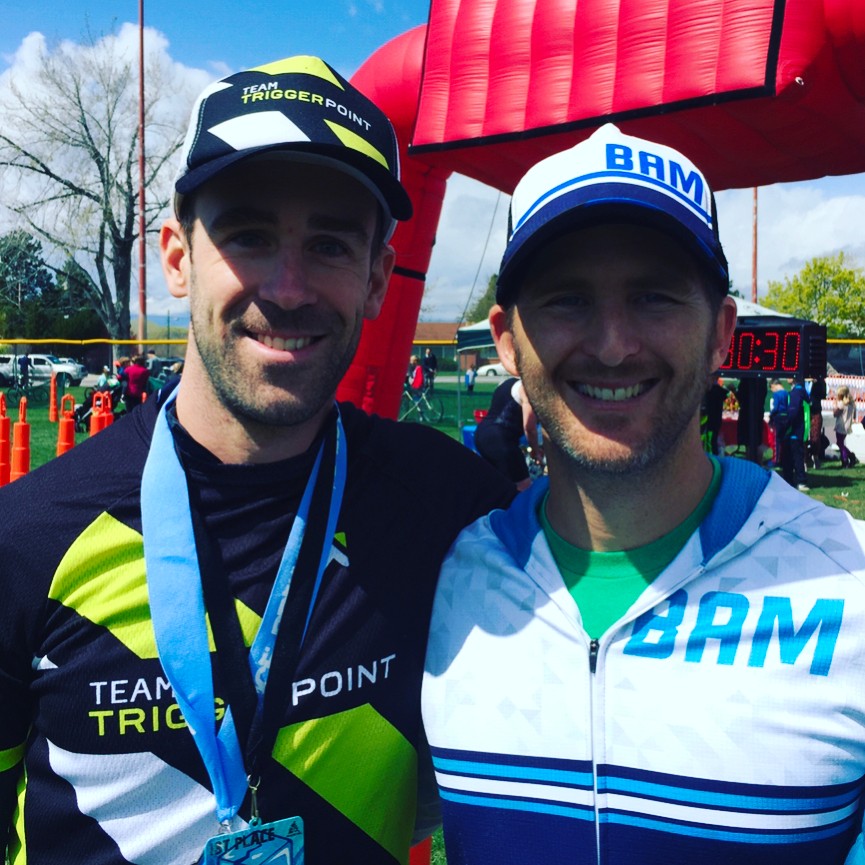In the news: “How A Utah Man Became A Triathlete By Changing His Morning Routines” – KSL TV Feature
Change your routines. Change your life.
Pleased that Aley Davis and the KSL (NBC) TV team asked me to share how routines helped me turn around my life and remain a core part of my success today. (If the video doesn’t show below, click here.)
Wanna try a tri? Come train with Balanced Art Multisport’s #bamtrifam and you’ll fall in love with training in a whole new way.
Or come to an Intermountain Tri clinic for a safe, welcoming space to learn basic skills in swimming, biking, running and triathlon.
Or if you’re not in the Utah/SLC region, check out www.mytimetotri.com (a project by USA Triathlon and IRONMAN) for tips and resources to give swimming, cycling, running and triathlon a go.
And you’re always welcome to ask me for ideas. I love when people reach out with questions about shoes, gear, training on heart rate, nutrition, what races to do, how to run faster …
Our bodies are incredible machines and a big part of my life is mastering mine and helping people celebrate theirs.
Notes:
- In Jan 2018, I co-founded Intermountain Tri and now serve as the president — join with just your email. Come just to swim, bike or run … or all three in triathlon.
- We host a bunch of weekly workouts year-round
- We put on (about) one instructional/technique clinic per month
It’s free to join: intermountaintri.com
- When I talk about consistently being up until 3a and having no habits … I’m talking about 18 months into having started my marketing business (launched Aug 2012; 2013 was ROUGH and I kept sliding right into Apr 2014). With no boss to report to, no office to show up to, and so on, there was no fixed activity pushing against the demands of my time. So everything got very loose. I lost sense of the day of the week. Weekends were indistinguishable, as was afternoon from morning and “too late” from “time to go to bed.” And my lack of strength with managing my own time became evident. Just as I crammed assignments and studying in school, I tried to cram client work. Hence the late nights. So many days, I would give myself a huge pep talk that “I’m waking up at 6a tomorrow to reset the cycle!” And then I would surely sleep until noon or 1p. And the cycle continued. For months. Until I did these three things to hijack the death spiral:
- Signed up for Ironman Maryland. I wanted to have a good experience and knew I had to train to succeed. I couldn’t just show up and wing it. It was too big a stress to waltz in.
- Asked someone who was already really good at getting up in the morning and going to bed on time for help. Many thanks to Erica Wiley for her gentle and supportive texts as I got sleep on track, starting with shutting down and going to bed at a consistent time.
- Committed to a training plan. I made half progress here with a half-marathon training plan I found and then peppering in runs and rides. But then I hired coach Alan Gulledge who really got me in gear.

- The cycling class I teach is the BAM Power Program.
- The workouts are written by sports medicine doctor and pro-cycling coach, Dr. Max Testa, of Park City.
- Anyone who rides any kind of bike for any purpose at any level of competition/interest/competitiveness can benefit from the classes because they start with an assessment of your present fitness and then are structured around helping you progress from there.
- It’s very different from a traditional gym/studio “spin” class, which is structured to burn calories. And it’s not like riding on Zwift or Trainer Road because you don’t waste effort “racing” people. Yes, we’re all in the same room (you can join online too!), but each person is in their individual zone, and there’s no leaderboard. It’s just a cool crew of people working hard together and supporting each other.
- Dr. Testa adjusts the classes each year based on his research and the real outputs of all his riders.
- Bottom line: it’s the most effective method possible for gaining fitness on the bike that makes you stronger and more efficient.
- My “healthy breakfast” they speak of is my homemade protein shake recovery mix.
- “Hitting a big reset button on my whole life” included moving to Salt Lake City Jan 2016 and using an app to create this monster morning routine, which I discussed in depth on the radio and followed to a T until Dec 2016 of that year when I hired BAM Coach Andrew Stasinos.
- The doc they interviewed is absolutely correct about momentum is your ally with routines.
- The momentum also comes, as he says, from “feeling much better than you did before.” Once you experience the state change, you know you can get it and will work to get it again.
- If your baseline is zero, just start moving. A gain of 1 is a gain from zero! Once you baseline is 1, then a gain to 2 is still a gain . . . and on and on, until you perform the routine 5-7 days a week no problem.
- At USA Triathlon Age Group Nationals in Aug 2018, I finished 20th in the Olympic-distance race and 10th in the sprint. End of summer 2019, I will wear the red, white and blue on Team USA at the ITU Age Group World Championship in Lausanne, Swizterland.
Watch (2:04) and read the whole KSL story here:
KSLtv also did stories on BAM Coach Suz Martin and BAM Coach Bill Fowler and his family.

